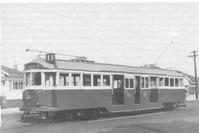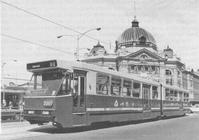


Chapter 7
I The First 100 Years 1788-1888
II Railways
i Location of the Railway
ii Track
iii Bridging and Tunnelling
iv Dams for Engine Water
v Locomotives and Rolling Stock
vi Signalling and Telecommunications
vii 1900/1988-The New Century
viii The Garratt Locomotive
ix Steam Locomotive Practice
x Motor Railcars
xi Signalling
xii Electric Tramways
xiii Electric Railways - Direct Current
xiv Electric Railways - 25 kV ac
xv Diesel Traction
xvi Alignment and Track
xvii Operations
III Motorised Vehicles
IV Aviation
V Modern Shipping
VI Innovative Small Craft
VII Conclusion
VIII Acknowledgements
IX Contributors
References
Index
Search
Help
Contact us

Electric Tramways (continued)
The Australian electric tram (Fig. 8) waxed before the motor bus and waned after the motor car. From 1905 to 1940 its technology evolved only marginally from the basic U.S. Edison- Sprague formula of 1890. After the artificial stimulus to all public transport of the Second World War its decline was progressive and rapid in all Australian cities, as public authorities compared the capital cost of re-equipping their worn out street railways, in the face of declining off peak traffic, against the lower cost of diesel buses. Only Melbourne persevered with and improved its electric tramway network, and today retains the second largest system in the western world.
The modern Melbourne tram (Fig. 9) -today the term 'light rail vehicle' is used -may still share the street with older vehicles of a derivative 1890 technology, but it is a totally different high technology vehicle. Its power is distributed by computerised control centre and solid-state rectifier sub-stations, and switched on the car by thyristor choppers under electronic control for stepless acceleration and regenerative braking. Its motors are frame mounted and as advanced in detail design as the latest railway motors. Its wheels are resilient; its air brakes and their throbbing compressor have been replaced by electric and magnetic rail brakes, which can better a motor car's stopping distance in an emergency. Even its trolley wheel has been replaced by a sliding carbon brush, and shortly its pole will be replaced by a pantograph collector.

The tram has become longer through articulation, and the techniques in its structure and manufacture have been so refined by local designers that the Australian LRV is now claimed to be competitive in cost with any in the world. Similarly, local techniques for all welded street railway track, set in machine laid concrete, are claimed to produce the least cost of any light rail track. Both claims have been substantiated by success in winning export orders. The track is Australian, and the body technology and total systems engineering also Australian. But economies of scale have meant that the source of the Australian tram's traction technology remains, as it always has, foreign -today from Germany.
People in Bright Sparcs - Macfarlane, Ian B.
 |
Australian Academy of Technological Sciences and Engineering |  |
© 1988 Print Edition pages 473 - 474, Online Edition 2000
Published by Australian Science and Technology Heritage Centre, using the Web Academic Resource Publisher
http://www.austehc.unimelb.edu.au/tia/467.html